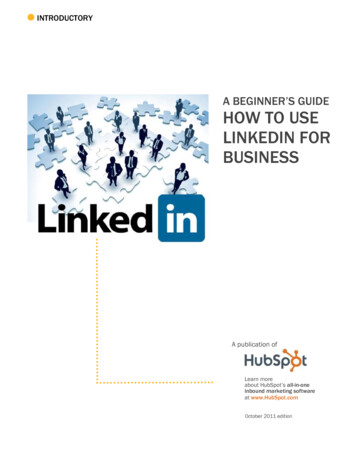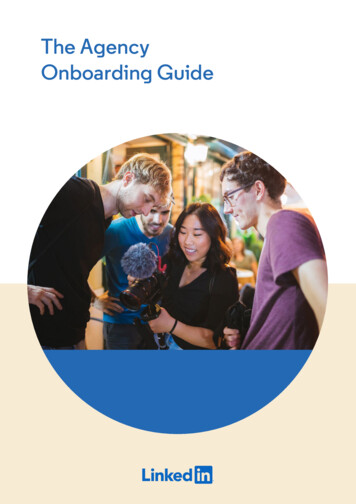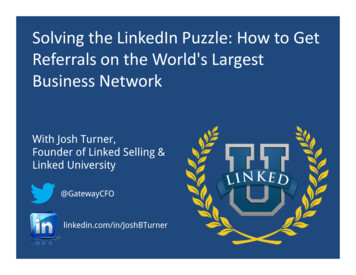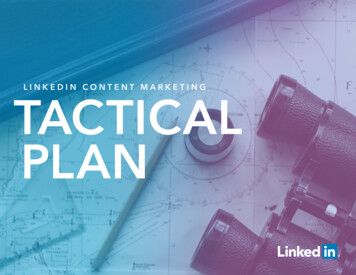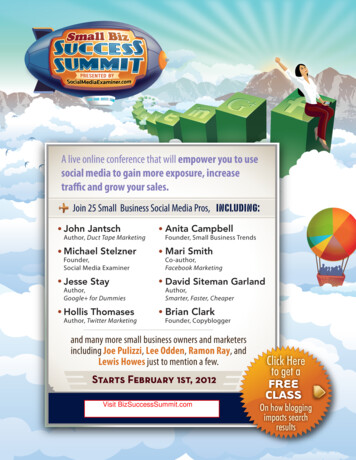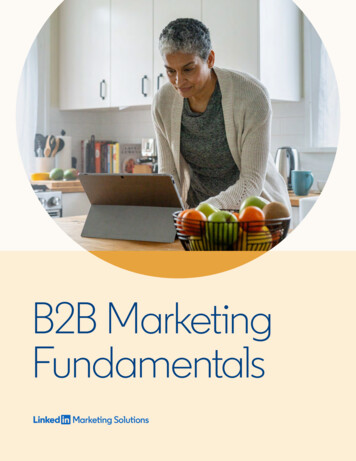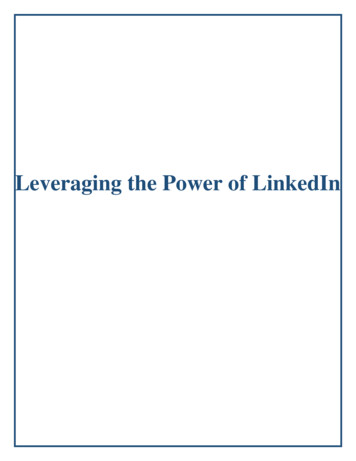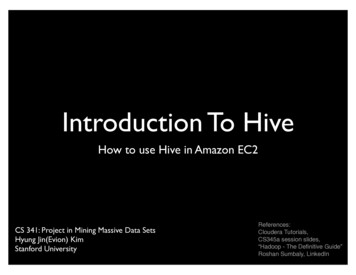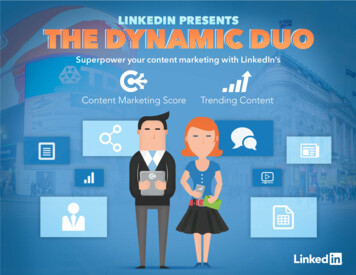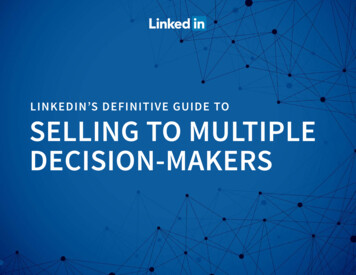
Transcription
LINKEDIN’S DEFINITIVE GUIDE TOSELLING TO MULTIPLEDECISION-MAKERS
INTRODUCTIONI’ve had the opportunity to talk to a number of business leaders — ranging fromsmall businesses to global enterprise companies to subject matter experts — usingsocial media to effectively grow their businesses. Throughout my conversationswith them, one worrying theme has emerged: They vastly overestimate how wellconnected their sales teams are with their client organizations. Not just by a little,but by a lot — and this puts them at risk of revenue loss.This gap between perception and reality should worry sales leaders deeply.Think about what would happen if your most successful salesperson left yourorganization, or your most vocal sponsor at your biggest client changed roles or leftthe company. How would that change your relationship with that client, and howwould it affect your business?How well-connected you are with your clients will have a direct impact on yourability to hit your targets. Relying on one connection puts your business at risk oflosing revenue if anything happens to that connection.There’s good news: This risk can be avoided if you take a new approach to makingconnections, one focused on forming multiple relationships at each client companyto create a strong network of ties to the organization.In this guide, you’ll learn everything you need to know about selling into multiplelines of businesses. After reading it, you’ll have a much deeper understanding ofwhat it is, why your business needs it, and how to develop your own matrixed salesapproach for driving real results.Let’s get started, shall we?Alex HisakaHead of Global ContentLinkedIn Sales SolutionsLinkedIn’s Definitive Guide to Selling to Multiple Decision-Makers 2
TABLE OF CONTENTSINTRODUCTION2 HAPTER 1:CMORE COMPLEXITY, MORE CHURN4ASK THE EXPERTKae Kronthaler-Williams, QvidianFady Daher, American ExpressMorgan Jones, Televerde Europe HAPTER 2:CBREAKING FREE OF THE ONE-RELATIONSHIP HABIT SK THE EXPERTARobert Knop, Assist You TodayFabian Au, IBM Digital GroupPaul Lewis, Pitney Bowes HAPTER 3:CUSING LINKEDIN TO CONNECT WITH MULTIPLE DECISION-MAKERS8111518ASK THE EXPERTGabe Villamizar, Lucid Software Inc.Wendy (McEwan) Hogan, OracleXavier Monty, Talentsoft22CASE STUDIES HCL Technologies NewVoiceMedia PGi25CONCLUSION29LinkedIn’s Definitive Guide to Selling to Multiple Decision-Makers 3
MORE COMPLEXITY,MORE CHURNLinkedIn’s Definitive Guide to Selling to Multiple Decision-Makers 4
MORE COMPLEXITY,MORE CHURNIt’s natural for a salesperson to gravitate toward a single contact personat a client company as the sales process progresses. You’ve spenta great deal of time together, and the conversations have probablyincluded a few anecdotes about the people you know and where youwent to school. Over time, you discover that you have several things incommon and develop a personal relationship.However, there are several people of influenceinvolved in a typical B2B purchase. In fact,there is an average of 6.8 people involvedin each B2B purchase decision, accordingto CEB — up from 5.4 in its previous research.That growth trend is reinforced by the 2016B2B Buyer’s Survey Report from Demand GenReport, which found that more than one-third(39%) of B2B buyers say the number of teammembers involved in the purchase processincreased in the past year; 6% say it increasedsignificantly. In addition, the bigger the sale,the more people have input. Purchases of 500,000 and up typically involve fiveor more buying centers and six to 10colleagues — sometimes more, according toSiriusDecisions’ 2015 B-to-B Buying Study.B2B purchase influencersare distributed acrossdivisions and functions:39%say the role ofexecutives inpurchasing decisionshas grown36.5%say the role ofoperations inpurchasing decisionshas grown32.7%say the role offinance in purchasingdecisions has grownPurchasing Decisions Are Cross-FunctionalNot only are there more decision-makersthan ever before; they’re also more diverse.Driven by a decentralization of organizationalstructures, the people who influence apurchase are likely to be distributed acrossdivisions, functional areas and even regions ofthe world. For example, C-level executives, lineof business owners and business managersall often play a role. In Demand Gen Report’s2016 B2B Buyer’s Survey Report, nearly 40%of buyers say the role of executives inpurchasing decisions has increased, morethan one-third (37%) say the role of operationshas increased, and nearly one-third (33%) saythe role of finance has increased.Source: Demand Gen ReportLinkedIn’s Definitive Guide to Selling to Multiple Decision-Makers 5
MORE COMPLEXITY, MORE CHURNDon’t Underestimate the Role of InfluencersB2B Sales Cycles Are ExpandingIn addition to the actual decision-makers,there are hidden “influencers” on purchasingwhose interests and goals may be less thantransparent to sales reps — that is, if repseven know who they are. “There is a shadowof decision influencers behind the decisionmaker. Those in the shadows always impactwhether a large deal will be awarded to you ora competitor — or whether the status quo willbe kept in place. They are not decision-makers.They can’t say ‘Yes.’ [But they] have the powerto resist or delay your proposal,” writes TOPOanalyst Tom Searcy in Sales ManagementDigest. Failing to build strong ties to even oneof these decision-makers or influencers couldresult in the collapse of important deals and,ultimately, in revenue loss for your organization.At the same time that individual tenure isshrinking, the B2B sales cycle is lengthening ascompanies spend more time debating purchasingdecisions. Smaller budgets, increased scrutinyby senior-level executives and the need to justifyspending make proving ROI more important thanever. According to Demand Gen Report’s 2016B2B Buyer’s Survey, more than 6 in 10 B2Bbuyers say they have started conductingmore detailed ROI analyses before making apurchase. Eighty percent say they spend moretime researching purchases than they did theprevious year, and 73% say they use more sourcesto conduct research and evaluate their options.Turnover Is Accelerating forDecision-MakersTurnover is another factor in the growingcomplexity and urgency of the sales process.The length of time an individual typicallyspends in a role is shrinking across industries.According to LinkedIn data, 1 in 5 decisionmakers (defined as those in “director-leveland-above” roles) turns over every year,and average tenure for the executive-level teammembers is two-and-a-half years. When yourorganization is selling multiyear relationshipsand the sales cycle is 12 months, 18 months orlonger, the risk that a crucial contact will moveon before you can close the sale is very real.Client Churn ThreatensBusiness RelationshipsEven after the sale is closed, what happens ifyour key contact in the client company leaves ormoves to another position in the organization?His or her replacement may have relationshipswith your competitors, or seek change for itsown sake. In SiriusDecision’s research, morethan 4 in 10 (42%) of B2B customers saythey’re unsure about renewing with currentvendors. No matter how long-standing yourrelationship, if you no longer have a contact atthe client company willing to advocate for yourbusiness, the account could be in jeopardy —and you could find yourself rapidly writing downyour next forecast amid risk of revenue loss.6 to10:The number of peopleinvolved in purchases of 500,000 or moreSource: SiriusDecisions1 in 5:The number ofdecision-makers(director-level-and-above roles)who turn over every yearSource: LinkedInAnd that’s just the churn on the client side.LinkedIn’s Definitive Guide to Selling to Multiple Decision-Makers 6
MORE COMPLEXITY, MORE CHURNTurnover for sales reps is nearly 1 in 4 peryear, according to CSO Insights’ 2015 SalesProductivity Optimization Study, and turnoverrates are on a growth trajectory, rising by 35%since 2014. In the Inside Sales for SaaS reportby Bridge Group, 12% of B2B companiesreport that sales rep turnover is anastounding 55% annually. The smaller yourorganization’s sales team, the greater impactthis type of turnover has on your ability to closesales. For a small company, with a modestsized or even one-person sales team, your fullsales function could turn over in the courseof 12 months. If losing a sales rep costs youhis or her contacts at client companies, yourorganization could face major revenue loss.account, runs the risk of being generic withyour message,” writes Carlos Hidalgos, CEOof Annuitas in his “Shiny Objects, DemandGeneration and ABM” blog post. Connectingwith more than one person allows you to tailoryour approach not just to the account, but alsoto each individual.Current Sales Strategies DemandMatrixed RelationshipsAdded together, these factors could lead torevenue loss of up to 40% for your company.As B2B sales become increasingly complex,and churn among both sales and client teamsgrows, companies who might have oncerelied on the one-to-one relationship betweentheir salesperson and a specific contact at aclient organization are rapidly discovering thattheir strategy is no longer viable. It’s time fororganizations of all sizes to adopt a new way ofthinking about their client relationships.As account-based marketing takes hold atmany organizations — 80% currently havea strategy or plan to develop one in thenext 18 months, according to DemandGen Report’s 2016 ABM Benchmark SurveyReport — forming multiple relationships ata client company becomes more valuable.“Simply focusing on accounts, rather than thepeople and the roles they serve as part of theYet the vast majority of sales teams arelagging behind when it comes to developingmultiple relationships with customers. Forinstance, in North America, just 9% ofsales reps’ relationships are matrixed,and 65% of customer relationships relysolely on one contact, according toLinkedIn data.In North America,just 9% of sales reps’relationships are matrixed,and 65% of customerrelationships rely solely onone contact.Source: LinkedInLinkedIn’s Definitive Guide to Selling to Multiple Decision-Makers 7
ASK THE EXPERT:KAE KRONTHALER-WILLIAMSVice President, Marketing QvidianLI: With more people involved in the buyingprocess than ever before, what challenges haveemerged for Qvidian’s sales teams with thisincreased complexity?KK-W: As more departments are now involved in thebuying process, keeping track of relevant contactsand proactively finding new ones to engage withhas become more complex. By opening the linesof communication and knowing the right questionsto ask, the Qvidian team is able to cope and thrivedespite this added complexity.Qvidian uses the “challenger methodology” toengage with prospects during the buying process— meaning Qvidian sales representatives areextremely knowledgeable about the prospect’sbusiness and industry. It’s important to havethe right information at hand when dealing withprospective new clients to understand their painpoints and how Qvidian is best able to assist.Social media channels, specifically LinkedIn, are alsoimportant in locating the right people within departmentsthat might not necessarily be present during initialconversations. With the use of LinkedIn’s SalesNavigator tool, it is easy to search for potential newcontacts and take initial discussions to the next level.LI: How do changes in internal and client rolesimpact the way Qvidian finds and engages withtarget buyers and influencers?KK-W: Turnover within a client organization can be amajor obstacle. To combat this, it’s important to beproactive and identify a group of key decision-makersearly on in the buying process. Building a strongrelationship with one decision-maker is important, butknowing additional staff that contribute to the processis important should the original contact leave.LI: How have your processes changed as aresult of these trends?LI: Are there any other trends that haveinfluenced your strategies?KK-W: Account-based marketing and advocacymarketing have really been around for a long time.The change is in the automation of marketingand what data insights it offers. Now, sales andmarketing organizations have greater informationon the buying behavior of their clients andprospects. Sales and marketing teams worktogether to build very targeted account plans thatresult in deeper relationships with the customersand expansion opportunities within the account.KK-W: In the past, the Qvidian team would bein touch with one or two contacts at the clientorganization throughout the buying process. Now itis vital to communicate with multiple individuals atthe organization.Qvidian attended the LinkedIn Sales Connect[conference] in NY which reinforced the benefitsof “multithreading” within a prospect account.The LinkedIn Sales Navigator tool enables theQvidian team to find the right contacts at anorganization, while also staying informed aboutcompany and organizational changes.LinkedIn’s Definitive Guide to Selling to Multiple Decision-Makers 8
ASK THE EXPERT:FADY DAHERVice President, Global Commercial Payments American ExpressLI: What are the business trends you haveseen surface in Australia that have created amore complex selling process?LI: How have new marketing strategiescontributed to the complexity in yourbusiness as it relates to the sales team?FD: There is definitely an increasing amountof cross-border trade and international tradetransactions occurring. In the B2B space, we’reseeing an increasing requirement for lending andcash flow, and opportunities to improve cashflow, which is different to the traditional corporatepayment environment.FD: We’re leveraging data to better understand ourclients, and to better understand the patterns thatare occurring, so that when we feed informationthrough to the customer, it is increasingly relevant,and not just customers, but also prospects. If we’refeeding information to a prospect, it’s not just thisstandard mail that goes out to everybody, hopingthat we get a 1% response rate. It is now a lotmore specific and targeted and relevant, so thatour response rates go from 1% to 10%.You now have to deal with the traditional and theemerging trends, which also means differentcontacts within an organization. Historically, wemay have dealt only with procurement. Nowwe deal with procurement, treasury and financeteams, so you’re dealing with various aspects ofan organization.As the needs multiply, it means you can’t have aone standard or one-size-fits-all approach. Youneed to start to improve your customization.LI: Which tools and processes haveyou implemented?FD: We have one consistent CRM that’s usedacross all teams: Salesforce. We’re capturing thecustomer-related data consistently, and we’re veryspecific about what fields need to be updated.LinkedIn Sales Navigator is our primary preference.We’ve made an effort to ensure not only do eachof the functions within our business in Australiahave it, but also globally. You’ve got cross-borderrelationships, and so, if we know that inSingapore or in Hong Kong or in London wehave a relationship with someone who’s quiteimportant to making a decision, we know thatwe can go through our colleague internally tohelp open a door and start a conversation.The importance of building relationships, theimportance of building trust is evident and willalways be there. When you build multiplerelationships it allows you to build trust quickerand ensures that everyone’s on the same page.LinkedIn’s Definitive Guide to Selling to Multiple Decision-Makers 9
ASK THE EXPERT:MORGAN JONESGeneral Manager Televerde EuropeLI: How has the implementation of new marketingstrategies heightened the need to engage beyonda single relationship? Have you embraced thesetactics within your company and, if so, how has itimpacted engagement and relationships?inbound and outbound outreach. We utilize socialchannels and events to reach targeted prospectsin countries with highly regulated email and phonerestrictions. Securing opt-ins across all touchpoints is a key strategy.MJ: We have been using a strategic account-basedmarketing approach with some of our clients.We’ve recently implemented ABM globally,leveraging our account reps across time zonesand adjusting to the unique needs and positioningof the European marketplace.LI: How have shifts in the economy in certainEMEA geographies impacted business and yoursales approach? How have these shifts influencedor guided the way you and your team build andmanage relationships with prospects and clients?Social selling is another strategy we’ve been using toengage with prospects globally. By utilizing a platformlike LinkedIn, we’re able to quickly identify targetaccounts in specific industries with specific titles andfunctions, and establish a common connection tofoster conversations.LI: Are there any implications of stricter dataprivacy regulations in Europe, such as agreater need for building relationshipsbeyond email, or retaining multiple anddeeper account relationships?MJ: The stricter data privacy regulations havehad the biggest impact on our go-to-market plansand campaigns, which are dependent upon bothMJ: Digging into the nuances of each countryand understanding each market and theireconomies is the key. We use segmentationtactics to focus on the industries specific toeach country to help home in on potential[prospects]. The largest economies in Europe(Germany, UK and France) are forecast to growat a rate of 1% to 2%. Ireland, Poland, Romaniaand Slovakia are forecast to grow at a rate above3%, and the others are in the middle. We use thistype of data to help understand how we shouldstaff our team appropriately, as well as prioritizeour market opportunities.LI: Are there any other trends specific to yourregion that pose risks and impact revenue results?MJ: Brexit remains an unknown. Its greatest risk isstalling growth plans in the UK because of economicuncertainties. Political changes in the US and howEurope will work with the new administration createsmore uncertainty. Attracting multinationals andmultilingual talent is very important to Televerde,so we are watching Brexit closely.LI: What processes have you implemented toassure your direct and inside sales teams adaptto these changes in their day-to-day activities?MJ: We train our teams using our proprietaryGlobal Campaign Excellence model and ourCall Performance Mastery program. The GlobalCampaign Excellence model combines 20 yearsof knowledge and experience generating demandand accelerating sales for our clients, along withindustry best practices. Our Call PerformanceMastery program ensures every agent receivesweeks of training and development, along withcertification levels — unprecedented for theindustry. We are continually modifying campaignand data intelligence-gathering processes toensure we are in compliance.LinkedIn’s Definitive Guide to Selling to Multiple Decision-Makers 10
BREAKING FREEOF THE ONERELATIONSHIP HABITLinkedIn’s Definitive Guide to Selling to Multiple Decision-Makers 11
BREAKING FREE OF THEONE-RELATIONSHIP HABITToday’s salespeople must develop strategies to ensure that they areinteracting with everyone in the client organization who has a stakein the purchase. So how can you go from point-to-point to morematrixed relationships?Start by instilling in your sales team themindset that for each and every relationshipmanaged by sales, you must establishmultiple connections at a target company. Thisapproach is critical to ensure that the dealprogresses even if one contact leaves the clientorganization or changes roles.Then, take these four steps:Step 1: Use social media to identifydecision-makers and influencersAccording to the 2016 ABM Benchmark SurveyReport, 94% of companies using accountbased marketing would like to identifytarget roles and titles at client companies,89% want to add richer information on existingcontacts, and 87% seek to add intelligence andinsights on key contacts. Social media can helpyou deepen connections in order to accomplishmany of these goals. Developing a web ofconnections at a company gives you a fullerpicture of the client’s needs and makes it easierto deliver personalized, targeted content.The more connections you make at acompany, and the more you interact withthem on social media, the more fully you’llunderstand how the various decision-makersand influencers work together. “[Sellers]need to go beyond just understanding howcustomers interact with them, to gaininga thorough understanding of how theywork, what is important to them and howthey interact with each other,” notes BrentAdamson of CEB. Building relationshipsthrough social media helps you learn who themanagers are within an organization, whocan say “yes” and who can say “no.” You’llalso discover who can help make the dealbigger by advocating for your business withinthe organization.LinkedIn’s Definitive GuideDrivingto SellingSocial Mediato MultipleAdoptionDecision-Makersand Revenue 12
BREAKING FREE OF THE ONE-RELATIONSHIP HABITStep 2: Help customers cut through the noiseAs buyers turn to social networks to exchangeinformation, seek counsel and provide advice,social media has become a major influenceon B2B sales. In a 2015 Blanc & Otus andG2 Crowd survey of B2B technology buyers,social networks, blogs and text messagingaccounted for 75% of how those buyersshare information.However, the sheer volume of content availableonline can overwhelm buyers and paralyzedecision-making. Sorting through all the datatakes time: In a survey conducted by CEB,84% of respondents said their buyingcycle was longer than projected in their initialestimates. In fact, the average purchase tookalmost twice as long as originally expected.Speed the sale along by helping buyers cutthrough the noise. Go beyond the value yourproduct or service offers; add value during theresearch stage by providing information tailoredto the needs of your matrixed connections.Getting the right information to the right personat the right time is critical to moving the salealong the pipeline. A recent Demand GenReport survey found that nearly two-thirds(65%) of buyers say the winning vendor’schoices about how and when to contactthem influence the buying decision.By keeping you abreast of multiple contacts’interests, concerns or questions, social mediacan alert you when the time is right to reachout to prospects with useful content, jump ona call to answer questions or suggest a faceto-face meeting.Step 3: Help buying teams build consensusEven when B2B buyers want to buy from you,it’s not always easy for them to do so. Witha growing number of stakeholders involvedin purchasing, internal disconnects betweenindividuals, departments and functions oftendelay the purchasing process or derail it entirely.Don’t count on one contact to make it work:CEB reports that 51% of customers whomight be willing to buy from a supplieraren’t willing to advocate for the supplierinternally to help get the deal done.Social networks, blogsand text messagingaccount for 75% ofhow buyers shareinformation.Source: Blanc & Otus and G2 CrowdIf they can’t reach consensus, frustrated buyersmay choose the path of least resistance —either sticking with their current vendor orbuying the lowest-cost (read: lowest-risk)solution available — not necessarily the bestone. Even if they purchase from you, buyinga less-than-ideal solution could backfire:Customers who end up regretting a purchaseare 53% more likely to advocate against thatsupplier in the future, CEB research shows.LinkedIn’s Definitive GuideDrivingto SellingSocial Mediato MultipleAdoptionDecision-Makersand Revenue 13
BREAKING FREE OF THE ONE-RELATIONSHIP HABITBy developing relationships with multipledecision-makers, you can provide theinformation each person needs to helpthe group reach an agreement. “The mostsuccessful sales organizations work to identifyand overcome the points of disconnectamong those stakeholders, connecting thesestakeholders to one another and driving themtoward consensus,” according to CEB. Whenyou help buying teams reach consensus, youmake it easier for customers to buy from you— and CEB data shows organizations thatmake buying easier are 62% more likely toconvert high-quality sales.Step 4: Add value — for the customer andfor your businessBuilding matrixed relationships isn’t just a wayto defend against risk of revenue loss. It canalso be a hugely powerful tool for businessgrowth and revenue enhancements. The morecontacts you have at a company, the morechances you have to spot new ways you canadd value to the organization. When any ofyour contacts move to new roles, departmentsor regions within the organization, seize theopportunity to explore additional ways yourbusiness can serve them.As you cross-sell and upsell that customer,you exponentially increase the customerlifetime value. It’s a cost-effective, resource-liteapproach to boosting sales.What about when your contact leaves acompany and moves to a new role at a newcompany? If you’ve successfully cultivated aweb of relationships at the client company, youdon’t have to worry about losing contact withthe organization. Instead, you gain a potentialnew client as you and your colleagues reachout to find additional connections at yourcontact’s new organization and build on theoriginal relationship.For a company with 50 clients and five keyrelationships within each of those organizations,using a matrixed approach could result in up toanother 50 new prospect targets each year, justby mapping existing and potential connections,and establishing the right relationships.LinkedIn’s DefinitiveThe DefinitiveGuideDrivingtoGuideSellingSocialto ManagingMediato MultipleAdoptionComplexityDecision-Makersand Revenuein Sales 14
ASK THE EXPERT:ROBERT KNOPCEO Assist You TodayLI: What are the risks of relying on relationshipswith one executive within target accounts?RK: I’ve seen risks on both sides. From the corporate perspective, say you have a great relationshipwith one sales rep at a vendor. He/she gives youa steep discount because [of your relationship]. Itcomes time to sign a new deal, and if that contact isno longer [there], your chances of getting that samediscount decrease. Let that vendor take you out tolunch once in a while, and make sure he/she bringstheir boss or another colleague. Connect with themon LinkedIn as well.From the vendor side, the risks are even greater.If that executive is your only point of contact, andhe/she leaves, you are in danger of losing a client.You can also lose a lot of time [by] only talking toone person. Early in my career, I ran an [ad] agency.I had been talking with a marketing director aboutoutsourcing certain roles and responsibilities to mycompany. After six months of conversations andlunches, she set up time to meet with her CMO. Ispent hours with my team prepping.The day of the meeting, we started our pitch. Fifteenminutes in, the CMO stopped us and said, “I apologize, but I didn’t know what this meeting was about.We can’t do any of what you are saying. We don’thave budget.”[We] wasted time and money that could have been[better] spent on another potential client. We wouldhave known better if we had done more researchand had more contacts [there].If you have multiple relationships at each company, itdramatically increases your network, which will allowyou to request more warm introductions. The morestakeholders you have a strong relationship with, thelower the chance of you being supplanted if one ofthem leaves.LI: What steps do you advise people to take inorder to assure they continually forgerelationships with multiple stakeholders?RK: LinkedIn is the main way I connect with additional team members at an organization. Building therelationship is all about adding value by providinghelpful information, sharing smart content and pinging them once in a while with an article that toucheson something you have spoken about previously.You can also stay top-of-mind by congratulatingthem on a promotion or a new role, and engagingwith their content.LinkedIn’s Definitive Guide to Selling to Multiple Decision-Makers 15
ASK THE EXPERT:FABIAN AUSales Specialist, Watson Analytics & Social Media Analytics IBM Digital GroupLI: What trends or disruptions encouraged IBM totransition from relying on single relationships tolarger networks of target buyers and influencers?FA: The change in persona from traditional IT buyersto line of business (LOB) buyers has disrupted howIBM used to work. LOB buyers now have moredecision-making and purchasing power as thebudget comes from them. Other demand includesSMEs and new start-ups increasingly adoptingtechnology. These are the people that IBM usuallydid not have relationships and contact with.LI: How did relying on single relationships impactacquisition, retention and revenue growth?FA: Limiting our relationship to just a singlerelationship jeopardized us from selling into differentlines of business within the same organization. Thismeans that we might be losing a lot of opportunitiesfor acquisition and growth as buyers from differentLOBs perceive value differently. LOBs are the endusers and are people we need to work with.LI: Have any specific trends changed the way yousee and build these relationships?FA: Yes, definitely. IT buyers think very differentlyfrom LOB buyers. Their purchasing behavior, suchas how they like to be engaged and what valuemeans to them, is very different from traditionalbuyers. The shift of buying power from IT tobusiness also means that there are more peopleto engage within a sales cycle, and each ofthese people are looking for their own value. Thiscomplicates the sales cycle and thus affects the waywe need to build relationships. The good news isthat with prior information about your prospect, suchas what matters to him or what he does, you canhelp reduce some of the complexity.LI: What tools and tactics have youimplemented to enc
report that sales rep turnover is an astounding 55% annually. The smaller your organization’s sales team, the greater impact this type of turnover has on your ability to close sales. For a small company, with a modest-sized or even one-person sales team, your full sales



